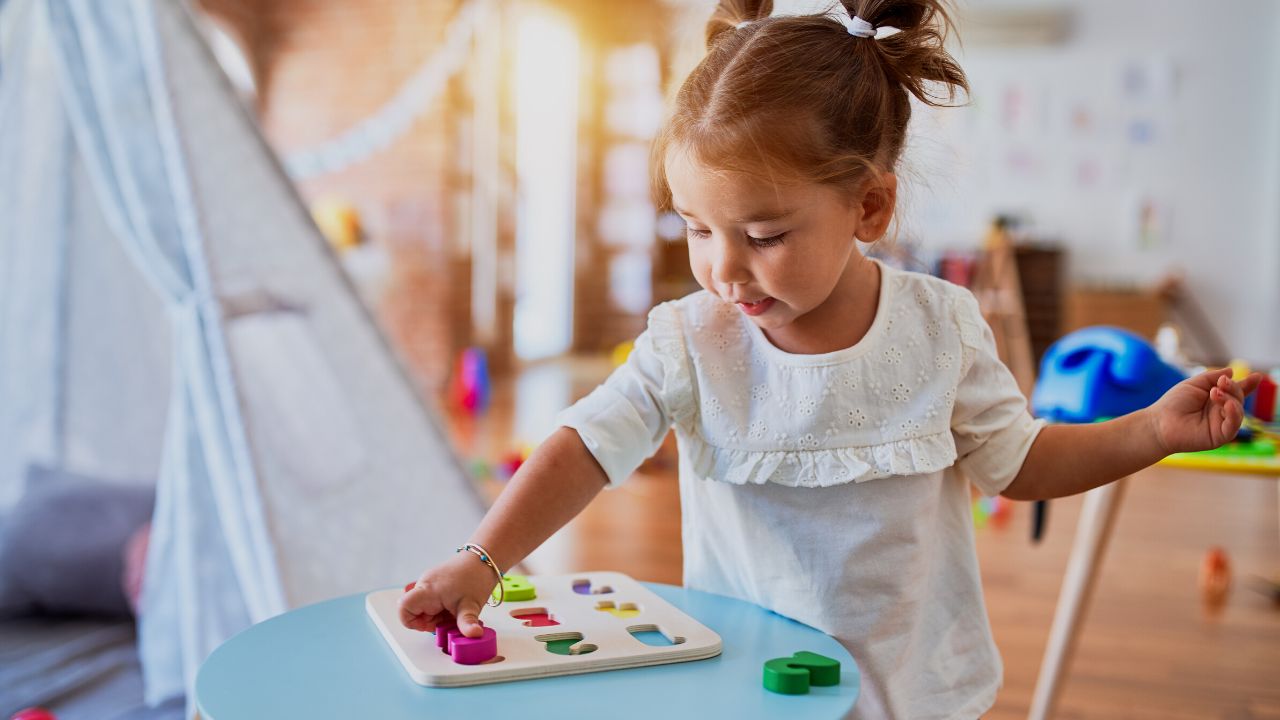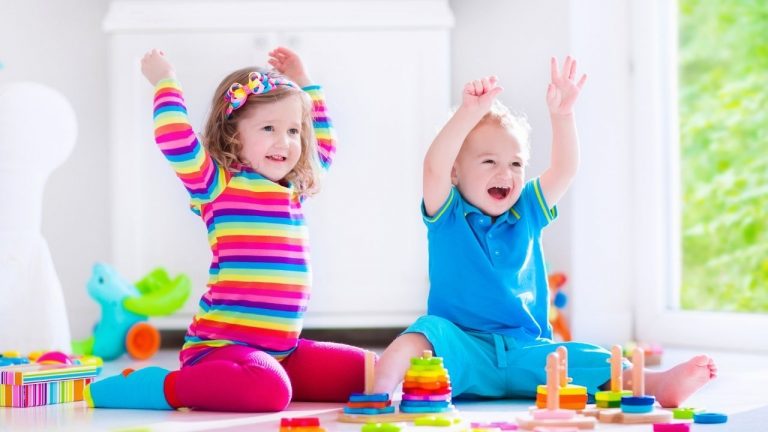10 Fun Brain Development Activities for 2-Year-Olds
This post may contain affiliate links and we may earn commissions when you make a purchase through these links (at no extra cost to you). See our disclosure policy for more details.
Simple Learning Activities to Do With Two-Year-Olds
Toddlerhood is, by far, my favorite stage in the parenting journey (so far, at least!). This is an incredible time in our kiddos’ lives when they’re learning and growing like crazy. It’s seriously SO MUCH FUN watching the wheels turn in their little minds.
Even at a young age, children understand much more than we often realize. A toddler’s brain is constantly developing. Which brings us to today’s topic: ten fun brain development activities for 2-year-olds.
While kids learn A LOT by simply exploring their environments and playing independently, there are plenty of ways we can encourage further development in super simple ways.
Frequent interaction, for example, teaches language and social skills. However, independent play is also an important skill to develop. Finding a balance between the two is key.
Without further delay, let’s move on to that list of learning activities for two-year-olds.
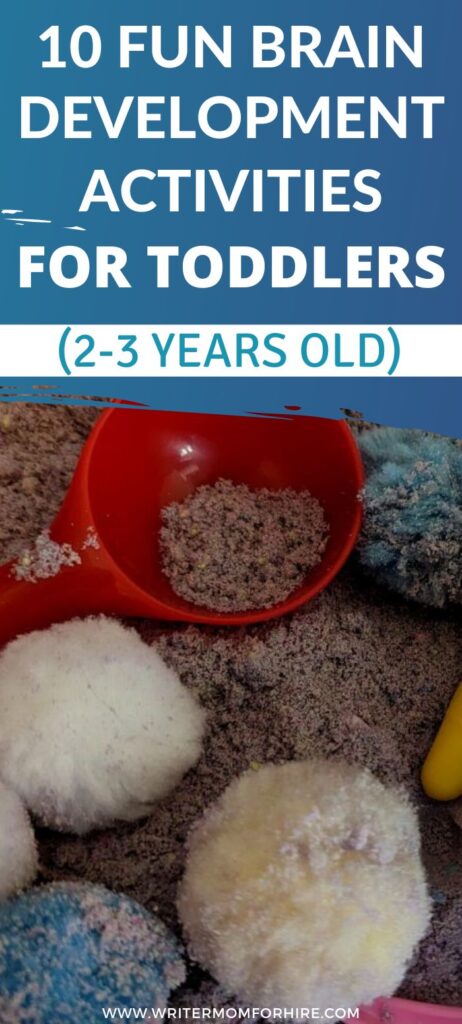
Brain Development Activities for 2 Year Olds
It can be overwhelming to come up with activities that will enrich a toddler’s brain development and further their overall development. Still, it might be more simple than you realize. In fact, you’re probably already familiar with most of the activities on this list.
1. Memory Game
Memory games are a fun and easy way to introduce your child to board games. Through engaging with memory games, your child will get to work on making connections, cause-and-effect concepts, and short-term memory.
You can either buy a pre-made memory game like this wooden travel game or make up your own paper version at home.
Puzzles are also helpful to utilize and they’re similar to memory games — both activities work on their understanding of spatial relationships.
You could also play the simple game of “What’s Missing?” Lay three to four items (toys, utensils, clothing items, etc.) in front of your child, and allow them a moment to observe and memorize what they see.
Tell them to close their eyes, and while their eyes are closed, remove one item. Once they open their eyes, have them guess what’s missing from the grouping of items.
2. Sensory Play
Sensory play is vital to a child’s development. It allows children to explore materials and concepts through their five senses in an open-ended and hands-on way.
Exploring with all of their senses helps children perceive the world around them more accurately and with more depth.
One of the most popular ways for a child to engage in sensory play is with a sensory bin. The components that make up a sensory bin include:
- a filler of some kind (uncooked rice, oats, etc.)
- themed items (artificial flowers for a spring-themed bin, animals for a zoo-themed bin, etc.)
- tools like funnels, tongs, and spoons
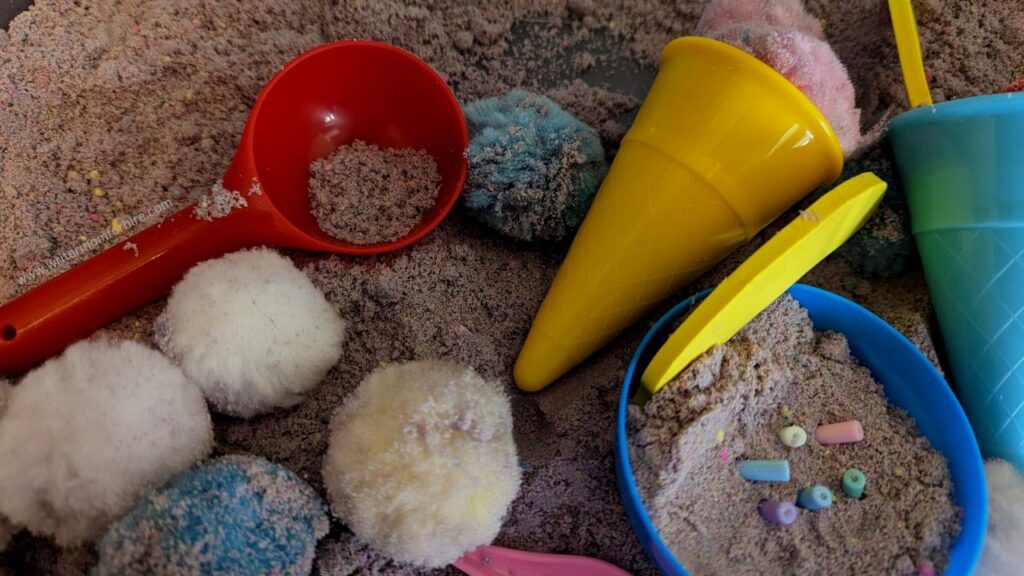
Sand and water play is another popular sensory play activity for children. Simply place sand and/or water in separate tubs, provide some tools like a funnel and cups, and let your little tot explore.
3. Sock Matching
This activity is fun for your child (and helpful for you!). Simply provide them with a small pile of their socks and ask them to find the corresponding mate. Once they find it, have them place the matching socks in a separate pile.
You can teach them to fold them and put them away once you feel that your child is ready for this step.
Participating in matching games is fundamental when it comes to strengthening a child’s cognitive development. It deepens their ability to concentrate on more complex tasks and improves visual skills, memory, and knowledge of patterns.
Color sorting activities help foster children’s cognitive development in the same way. (My girls absolutely adore this dinosaur sorting set!)
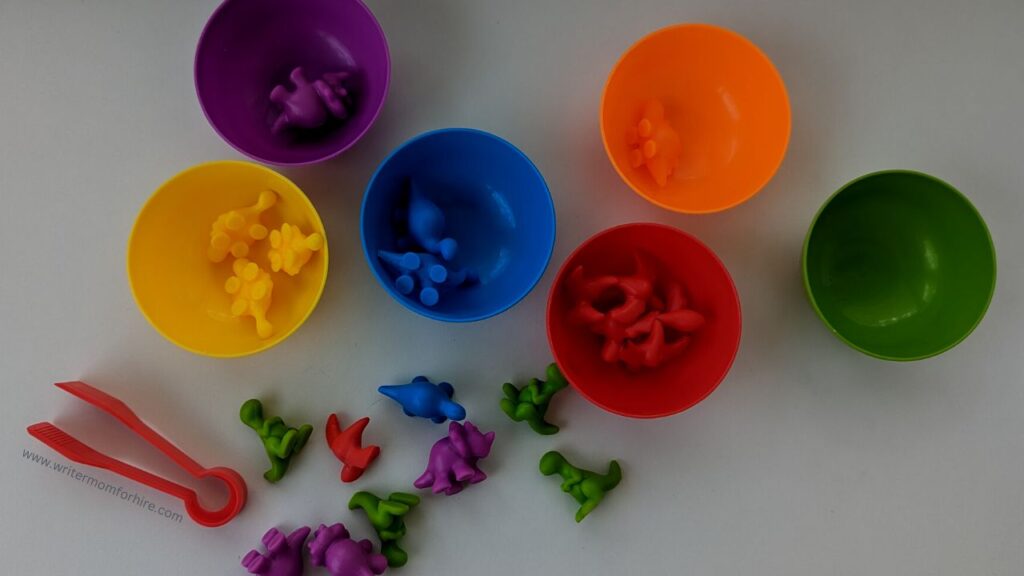
4. Contact Paper Sticking
This activity is super simple and will likely engage your child for a good, long time.
Tape the edges of a sheet of contact paper to the wall or to a tabletop, sticky side up. If you don’t have contact paper, you can use the sticky side of packaging tape to make a smaller-scale version of this activity.
Then provide your child with craft items to stick on the contact paper, such as craft poms, sequins, feathers, and more. You could also use food items, like oats and cereal.
5. Pom-Pom Sorting
Using a muffin tin, fill each compartment with a craft pom of each color. Or, if you prefer, you could also put a different colored sticker on the bottom of each compartment.
Your child will then take a pom pom from the pile and figure out which muffin tin compartment each one belongs in, matching them by color. If you have various sizes of pom poms, you could also try matching them by size.
6. Pretend Play
Dramatic play sparks a child’s imagination and encourages creative thinking. It’s very open-ended which allows your child to take a primary role in their play.
Pretend play also works on developing their social-emotional skills which is a crucial aspect of overall brain development. All you have to do is provide them with some pretend play items and they will take it from there.

Helpful items for dramatic play include:
- A play kitchen
- Play food
- Toy pots and pans
- Old kitchen utensils
- Toy shopping cart
- Dress-up clothing
- Old glasses frames
- A doctor’s kit
Rest assured, you don’t need a ton of stuff. If they haven’t already, your kids will likely create their own items from things they find around the house. (Mine are pros at re-purposing cardboard boxes!)
A shoebox can become a makeshift laptop, the remote control becomes a pretend cell phone, and so on.
Their imagination will take them away. To encourage them even further, you could facilitate an improv game with them by giving them a scenario to act out however they choose.
Pro Mom Tip: Take it a step further and engage in the improvisation game every once in a while. Participating in the imaginary world they create will further encourage their play while also strengthening your bond.
7. “Rescue the Animals”
This animal rescue activity works on your child’s fine motor skills as well as vital cognitive skills, such as concentration, problem-solving, and persistence.
Simply tape animal toys or figurines to a dry-erase board or tabletop. You could also tape them to the wall, the floor, or a piece of cardboard.
Honestly, you can make use of anything you have on hand for this activity. Masking tape or painter’s tape works best for securing the toys, since it comes off the easiest.
Encourage your child to “rescue” the animals by peeling off the tape and freeing the animal figurine. This works on their understanding of cause-and-effect and their problem-solving skills.
8. Magnetic Tiles
Playing with blocks or other building toys, such as Magnatiles, is very impactful on a child’s brain development. When your child builds with magnetic tiles, they are encouraged to configure the tiles in many different ways, making it extremely open-ended.
In fact, my girls use their Magnatiles to build little houses or stables for their ponies, and we’ve even used them as a homeschool tool for creating 3D shapes.
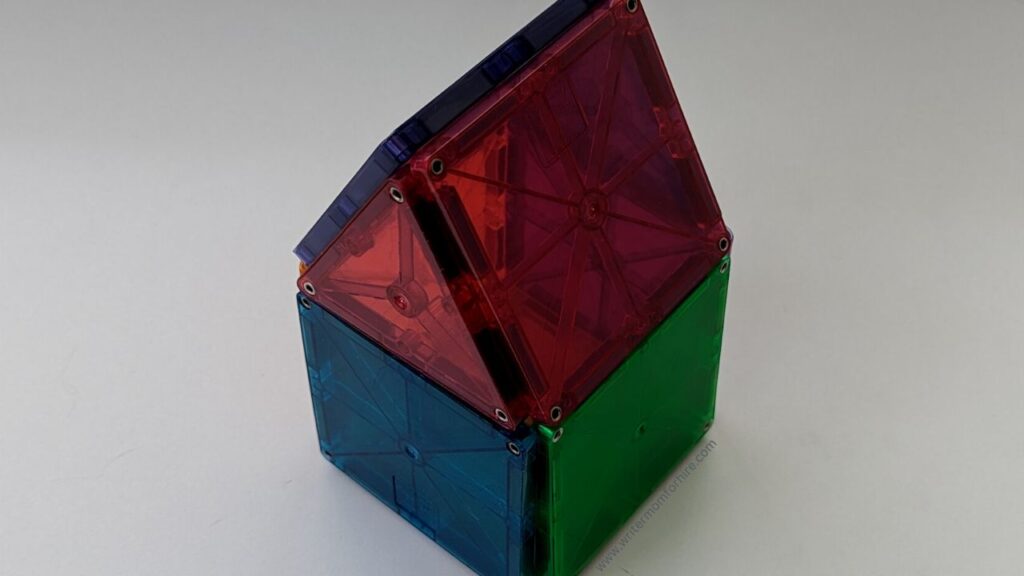
A fun and creative way to facilitate Magnatile play for your child is by allowing them to play with them on a light table or by sticking them onto the refrigerator.
As your child builds with blocks or Magnatiles, their creative abilities grow and their motor skills are strengthened. Cognitively, their understanding of spatial relationships will be intensified and their persistence ability deepens.
9. Scavenger Hunt
There are a few ways you could facilitate a scavenger hunt activity for your child.
You could create a hide-and-seek sensory bin and hide items (such as puzzle pieces or letters of the alphabet) in uncooked rice or any other sensory bin filler.
Or you could purchase or create scavenger hunt cards to play with at home or on the go. We have this Kids Scavenger Hunt card game that our girls enjoy playing at home, outside, or in the car (pictured below).
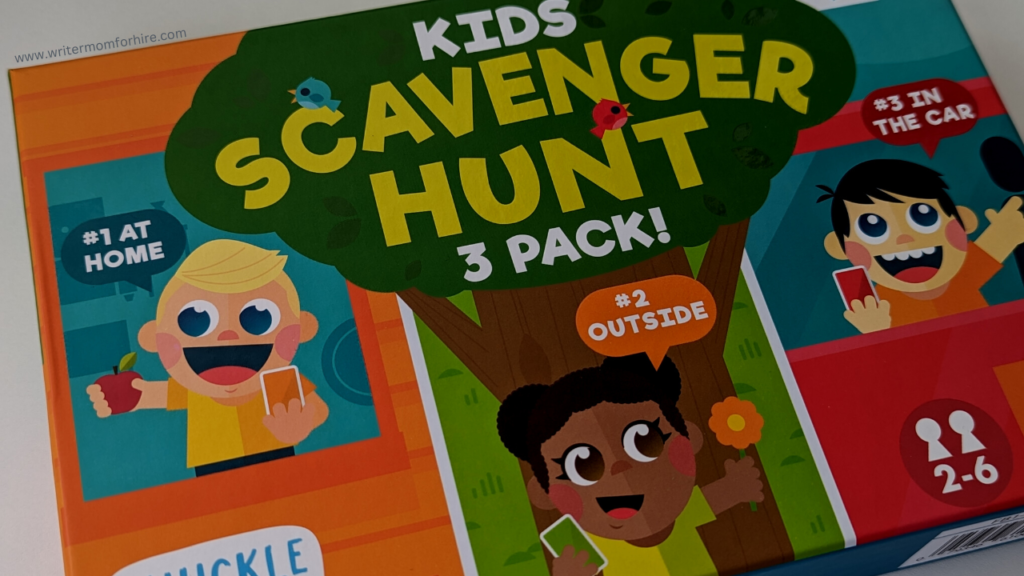
You can find a similar, toddler-geared scavenger hunt right here.
There’s also the option of playing the classic childhood game of hide-and-seek, which is always a hit! I-Spy is another fun seeking game (and hugely popular in our house!) that works on similar aspects of cognition.
10. Scoop and Pour
Scoop and pour activities are great for boosting a child’s fine motor skills, but they’re also very helpful in strengthening cognitive development.
Provide your child with two small tubs; one filled with ice cubes and the other filled with water. Encourage them to scoop and pour the ice cubes from one tub to the other using a slotted spoon or soup ladle.
You could even provide a variety of tools for them to transfer the ice such as tongs, measuring cups, a ladle, and more. Add food coloring to the water for an extra visual element.
This activity develops a child’s cause-and-effect thinking, perseverance, persistence, problem-solving, and concentration.
Brain Development in Two-Year-Olds
The development of a child’s brain is built upon and heavily based on cognitive development. Cognitive development is the pillar of child development and human development as a whole.
Simply put, cognitive development is the ability to think and reason through things. Your child’s brain function is crucial to their development and overall life.
During the first few years of a child’s life, their cognitive development is rapidly growing. These cognitive skills they gain during their early childhood will help them make sense of the world around them and carry them for the rest of their lives.
Time to Play!
For healthy brain development in children, it’s vital to provide nurturing and responsive care. Having a few fun activities in your back pocket can be really helpful, too.
This list covers only ten of many, many brain development activities for 2 year olds. Hopefully it has inspired you to come up with some of your own games to try with your toddler, while also encouraging them to play independently (thus allowing you the occasional break!).
Enjoy!
More Toddler Fun:
5 Toddler Craft Subscription Boxes (That Busy Moms Will Love!)
How to Make Tooth Brushing Fun for Toddlers
18 Engaging Activities to Teach Colors to Toddlers & Preschoolers

